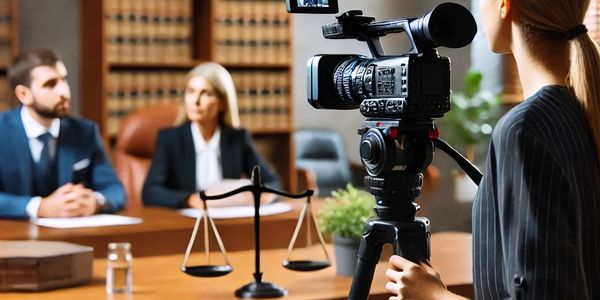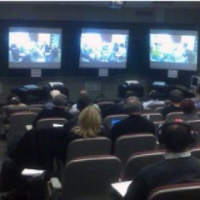Why Lawful Videography Is Vital for Accurate Court Recordings
The duty of legal videography in courtroom setups can not be overemphasized, as it functions as an important device for maintaining the stability of court records. By recording both spoken and non-verbal communication, it boosts the clearness of witness statements and reflects the subtleties of court interactions. This thorough paperwork not only aids in decreasing prospective misunderstandings but additionally supports appellate testimonials, consequently reinforcing the judicial procedure. The ramifications of incorporating legal videography right into conventional court room practices elevate essential inquiries about its broader effect on the legal system. What might these effects entail?
Relevance of Visual Proof
In the realm of legal procedures, the relevance of aesthetic evidence can not be overstated. Visual evidence functions as an effective tool in establishing facts, supporting statements, and improving the total quality of a case. This sort of evidence, which includes photographs, videos, and representations, can supply a concrete context that spoken summaries usually lack, thereby providing juries and judges a clearer understanding of the situations surrounding a situation.
Furthermore, visual evidence aids in the retention of information. Human cognition is inherently aesthetic, and individuals are extra most likely to keep in mind and understand details provided in an aesthetic format. In the courtroom, this can be essential, as compelling visual proof can guide viewpoints and strengthen the narrative presented by lawful reps.
Furthermore, making use of visual proof can decrease misconceptions and uncertainties that usually occur from spoken exchanges. By supplying a direct representation of occasions, visual evidence aids to get rid of subjective interpretations and promotes a much more objective examination of the realities. The combination of visual proof into lawful proceedings not just enhances the honesty of the judicial process however also boosts the possibility of attaining a just end result.
Catching Non-Verbal Signs
Using innovative videography strategies can substantially enhance the capture of non-verbal hints throughout legal process. Non-verbal communication, including face expressions, body language, and eye get in touch with, plays a vital role in communicating feelings and objectives that might not be clearly stated in spoken testament. legal videography. Legal videography utilizes high-definition cams and tactical angles to make sure that these refined cues are taped with quality and precision
The capability to examine non-verbal actions can offer beneficial context to statements made during court sessions. As an example, a witness's hesitation or self-confidence can be interpreted with their pose or motions, possibly influencing the court's assumption of integrity. In addition, the usage of close-up shots can aid focus on a speaker's expressions, enabling a more nuanced understanding of the testimony.
Furthermore, integrating multiple camera angles can create an extensive view of interactions, highlighting dynamics in between events entailed. This complex technique not just improves the accuracy of the court record yet additionally help in maintaining the honesty of the judicial procedure - legal videography. Eventually, catching non-verbal cues via lawful videography promotes a richer, much more complete representation of court room process

Enhancing Testament Dependability
The reliability of testament can be substantially reinforced through making use of premium legal videography. Video recordings offer as an objective tool that catches not just the spoken words of witnesses yet also the subtleties of their shipment, consisting of tone, pacing, and emotional expressiveness. This complex documentation supplies a clearer understanding of the witness's integrity and objectives, which can be crucial in legal procedures.
In addition, lawful videography reduces the possibility for misconceptions that might occur from composed records alone. When jurors can observe a witness's behavior and body movement along with their statement, they are much better equipped to evaluate the credibility and integrity of the evidence presented. This visual context can enhance the testimonial narrative, making it a lot more engaging and reliable.
In addition, the visibility of a video clip recording can deter potential disparities in statement. Witnesses might be extra cautious in their statements when they understand they are being taped, bring about even more accurate and truthful accounts. In general, top notch lawful videography boosts the honesty of testament, ensuring that the court has access to a complete and honest representation of the facts as conveyed by the witnesses.
Supporting Appeals and Reviews
Legal videography plays a vital function in sustaining allures and evaluations by offering a detailed aesthetic document of court procedures. This visual documents records not just the spoken words of witnesses and attorneys but also the nuances of body movement, intonation, and court room dynamics. Such elements can be pivotal in understanding the context of testimonies and debates provided.
In the appellate process, where the focus gets on mistakes of legislation and procedural fairness, a video clip record can act as a vital device for appellate courts. It makes it possible for judges to review the original trial context, making certain that choices are based on a full understanding of Recommended Reading the procedures. The ability to aesthetically examine the temperament of witnesses or the interactions between events can disclose insights that created transcripts may ignore.

Additionally, lawful videography can aid in clearing up ambiguities in testimonies or step-by-step rulings, see this page therefore strengthening the basis for an allure. By providing a reliable, unbiased account of what taken place in court, legal videography not just supports the stability of the legal procedure but likewise encourages all parties included to make enlightened decisions concerning their instances.
Streamlining Court Processes
Enhancing court room effectiveness, lawful videography simplifies processes by offering instant accessibility to aesthetic documents of proceedings. This technology allows judges, attorneys, and juries to review essential testimony and evidence, guaranteeing that all celebrations have a clear understanding of the situation. By catching the nuances of verbal and non-verbal communication, videography enhances the record, making it simpler to comprehend the context and weight of statements.

In addition, video recordings can help with remote engagement in hearings, permitting higher versatility in scheduling and participation, which is especially important in intricate situations entailing multiple stakeholders.
Verdict
To conclude, legal videography plays a crucial role in making certain accurate court recordings by giving vital aesthetic evidence that records both verbal and non-verbal interaction. This practice boosts the reliability of statements, sustains appellate evaluations, and simplifies court procedures. By fostering a detailed understanding of courtroom dynamics, lawful videography ultimately contributes to extra equitable judicial results, enhancing the integrity of the lawful system and promoting notified decision-making.